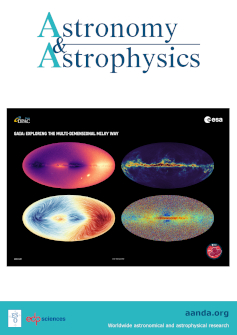Detection prospects of very and ultra high-energy gamma rays from extended sources with ASTRI, CTA, and LHAASO
IF 5.4
2区 物理与天体物理
Q1 ASTRONOMY & ASTROPHYSICS
引用次数: 0
Abstract
Context. The recent discovery of several ultra high-energy gamma-ray emitters in our Galaxy represents a significant advancement towards the characterisation of its most powerful accelerators. Nonetheless, in order to unambiguously locate the regions where the highest energy particles are produced and understand the responsible physical mechanisms, detailed spectral and morphological studies are required, especially given that most of the observed sources were found to be significantly extended.Aims. In these regards, pointing observations with the next-generation Imaging Atmospheric Cherenkov Telescopes, such as the Cherenkov Telescope Array (CTA) Observatory and the ASTRI Mini-Array (ASTRI), are expected to provide significant improvements. Here we aim to identify the most promising sources to target in future observations.Methods. For this purpose, we performed a comparative analysis of the expected performance of ASTRI and CTA, computing their differential sensitivities towards extended sources, and further explored their capabilities with respect to specific case studies, including follow-ups of existing gamma-ray source catalogues.Results. We find that almost all of the sources thus far detected by LHAASO-WCDA and in the H.E.S.S. Galactic Plane Survey will be in the reach of ASTRI and CTA with about 300 and 50 hours of exposure, respectively. For the highest energy emitters detected by LHAASO-KM2A, in turn, we provide a list of the most promising objects that would require further investigation. We additionally examined specific classes of sources in order to identify potentially detectable gamma-ray emitters, such as passive molecular clouds (i.e. illuminated by the cosmic-ray sea) and pulsars surrounded by a halo of runaway particles.背景最近在银河系中发现了几个超高能量伽马射线发射器,这标志着在描述银河系最强大加速器的特征方面取得了重大进展。然而,为了明确定位产生高能粒子的区域并了解其物理机制,需要进行详细的光谱和形态研究,特别是考虑到大多数观测到的源都有明显的延伸。 在这些方面,利用下一代成像大气切伦科夫望远镜(如切伦科夫望远镜阵列(CTA)天文台和应科院小型阵列(ASTRI))进行定点观测有望取得重大改进。在此,我们旨在确定最有希望成为未来观测目标的光源。为此,我们对 ASTRI 和 CTA 的预期性能进行了比较分析,计算了它们对扩展源的不同敏感度,并进一步探讨了它们在具体案例研究方面的能力,包括对现有伽马射线源目录的跟踪。我们发现,迄今为止由 LHAASO-WCDA 和 H.E.S.S. 银河系平面巡天探测到的几乎所有源,在分别曝光约 300 小时和 50 小时后,都将进入 ASTRI 和 CTA 的探测范围。对于 LHAASO-KM2A 检测到的最高能量发射体,我们则提供了一份需要进一步研究的最有希望的天体清单。此外,我们还研究了一些特定类别的来源,以确定可能被探测到的伽马射线发射体,如被动分子云(即被宇宙射线海照亮)和被失控粒子晕包围的脉冲星。
本文章由计算机程序翻译,如有差异,请以英文原文为准。
求助全文
约1分钟内获得全文
求助全文
来源期刊

Astronomy & Astrophysics
地学天文-天文与天体物理
CiteScore
10.20
自引率
27.70%
发文量
2105
审稿时长
1-2 weeks
期刊介绍:
Astronomy & Astrophysics is an international Journal that publishes papers on all aspects of astronomy and astrophysics (theoretical, observational, and instrumental) independently of the techniques used to obtain the results.
文献相关原料
| 公司名称 | 产品信息 | 采购帮参考价格 |
|---|
 求助内容:
求助内容: 应助结果提醒方式:
应助结果提醒方式:


